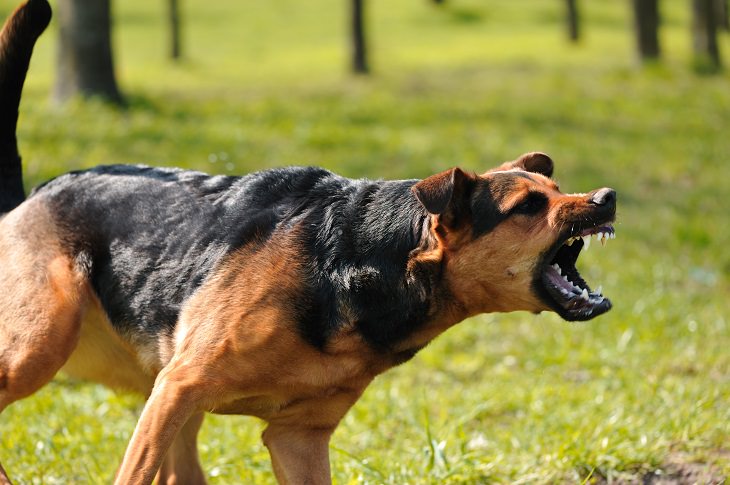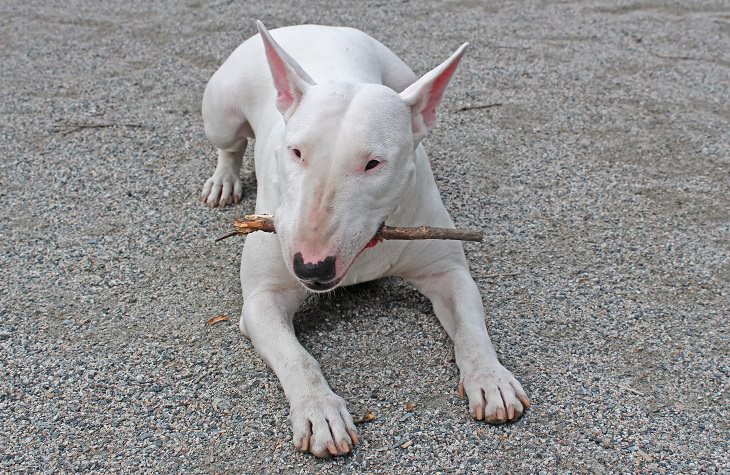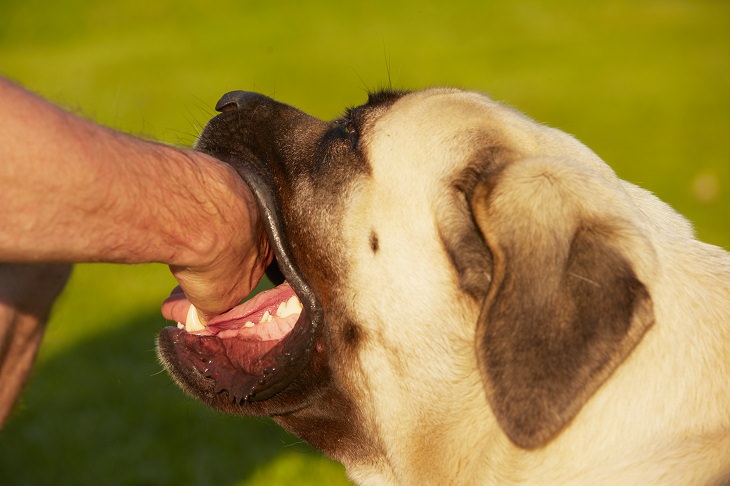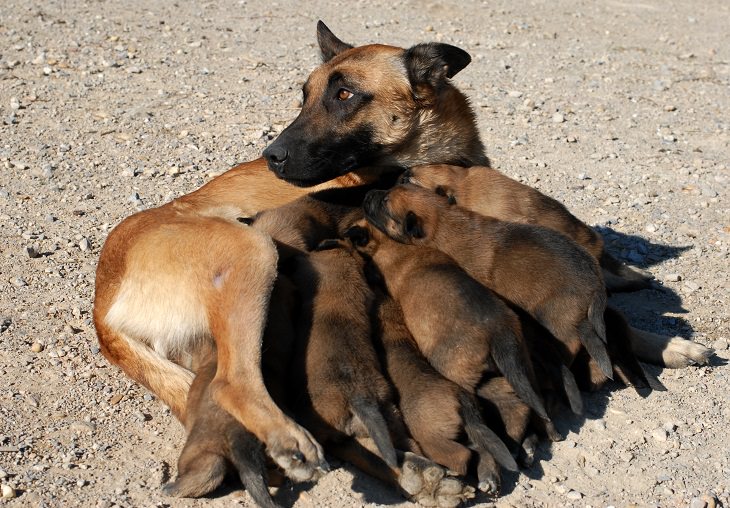

Part 1: Warding Off an Attack
1. Don’t Panic
There is some truth to the adage that states that dogs and other animals can “sense fear.” If you become agitated and run or scream, you may give the dog more confidence, or worse, you may appear threatening to the dog. You do not want to be in either of these situations.
2. Make Yourself Rigid and Motionless
If an aggressive dog approaches, stand still with your hands at your sides, like a tree, and do not look him in the eyes. In most cases the dog will lose interest and walk away.
• Don’t wave your arms about or kick out with your legs as the dog may see these actions as threatening.
• Don’t make eye contact as this may cause the dog to lunge.
• Stand sideways to the dog and keep him in your peripheral vision. This will signal to the dog that you’re not a threat.
• Don’t open your hands and arms up to a bite by extending them. Keep your fingers curled into fists to avoid getting them bitten.
3. Don’t Try to Run Away
Trying to run away might awaken the dog’s prey instinct to chase and catch animals. Therefore, he may pursue you, even if his initial intent was just playful. You will not be able to outrun most dogs, so it’s not really worth the effort.

Part 2: Defending and Protecting Yourself
1. Face the Dog and Command, “Back Away”
If the dog continues to be aggressive, your pacifying attempt has not worked, face him and sternly command him to leave.
• Use a strong, deep, and commanding voice.
• Keep eye contact.
2. Fight Back Against an Attacking Dog
If the dog lunges and starts to bite you, you’ve obviously got to defend yourself. To do this, try to kick the dog in the nose, throat, and the back of the head. This will stun the dog and give you time to escape.
• It’s okay to raise your voice at this point. Yell for help as you’re fighting back as other people will hopefully come to your aid. However, it’s best to avoid screaming as this may lead to the dog becoming more aggressive.
• If you have a stick or something else you can use as a weapon, you should use it to hit the dog. Don’t hit the dog over the top of the head though, as dogs have thick skulls, so this will just make the dog angrier.
• Fight as though your life depends on it, because it does – dog attacks can be fatal.

4. Protect Your Face, Chest, and Throat
If you get knocked to the ground during the attack, not only will it be more difficult to fight the aggressive dog, but vital areas such as your torso, neck, and head will be more open to attack. These are the most important parts of your body to protect as bites in these places can cause serious damage, and even death.
• Protect your vitals by rolling onto your stomach, tucking your knees in, and bring your hands (balled into fists) up to your ears.
5. Leave the Area Slowly and Carefully
If the dog loses interest in you, leave the area slowly by backing away without sudden movements. Staying calm in a situation like this is easier said than done, but it’s the best thing to do so long as the dog isn’t biting you.
Part 3: Handling the Aftermath
1. Attend to Any Wounds
If you have been bitten, promptly take yourself to the hospital! Don't take any chances! However, if you aren't able to or need to wait for an ambulance, take care of any wounds, as even minor bites can cause infections.
• Apply gentle pressure to stop any minor bleeding. Use a clean cloth or sterile gauze pad. If the bleeding is serious and you can’t get it to stop, seek medical assistance immediately.
• Wash the wound thoroughly with warm water and soap.
• Dress the wound using a sterile band-aid for small cuts or sterile bandages for larger lacerations.
• Keep a close lookout for any signs of infections, such as redness, tenderness, warmth, or oozing pus. If you get any of these symptoms, it’s best to go see your doctor.
2. Call the Authorities
It’s very important to determine whether the dog that attacked you has rabies or a history of aggression. Call the authorities immediately after a dog attack so that the dog can be prevented from attacking anyone else, and can be tested for diseases.
• If the dog that attacked you was a stray, he may attack others, too. Removing him from the environment will protect yourself and others.
• For dogs with their owners nearby, how you handle the situation after the attack is entirely down to you. For example, if you’ve been hurt you might feel like taking legal actions.
3. See a Medical Professional Promptly
If you have been bitten by an unknown dog, a dog that was later found to have rabies, or a dog that seemed to be foaming at the mouth, it’s crucial that you visit your doctor straight away to get some preventative treatment for the deadly rabies disease.
• The rabies shot sequence, if necessary, should be started as soon as possible after the bite.
• If you haven’t had a tetanus shot in over 5 years, you might be required to have one.
• Any significant wound from a dog attack needs to be examined by a medical professional.
Part 4: Taking Precautions Against Attacks
1. Look for Warning Signs
Most dogs are not aggressive, but are just curious or defending what they think is their territory. Therefore, to avoid unnecessary conflict, it’s vital that you know how to tell if a dog is just playing or is being truly aggressive. Here are some common signs of aggression that you should keep an eye out for.
• Growling, snarling, and teeth baring are all obvious signs of aggression and should be treated as such.
• An angry dog may show the whites of their eyes.
• Pulled back ears lying flat against the head is a telltale sign of aggression.
• A dog who looks tense, straight, and stiff (head, shoulders, and hips aligned) could mean business.

• Never annoy a dog who’s eating or caring for puppies as they are extra-protective during these times.
• Avoid smiling at the dog. You may think that you’re being friendly, but an aggressive dog sees you baring your teeth for a fight.
• Dogs that have been chained to stationary objects for long periods of time are more likely to be aggressive, so don’t approach them.
3. Assume all Unknown Dogs Are Threats
In general, the best policy to follow when it comes to dog attacks is to do everything you can to avoid them in the first place. If you see a dog that looks dangerous, just stay away.
• Report any dangerous-looking dogs to the local authorities.
• Teach your children not to approach unfamiliar dogs.
• Give all unknown dogs a wide berth until you are sure that they are safe.
Remember: Dogs are not naturally inclined to attack humans unless they feel that themselves, their territory, or their pack is under threat. We will not always be able to avoid aggressive dogs, but by arming ourselves with this knowledge, we will be better prepared to prevent a dodgy situation from escalating, minimalizing the damage if a dog does decide to attack.
Source: wikihow and cesarsway
Photos: depositphotos